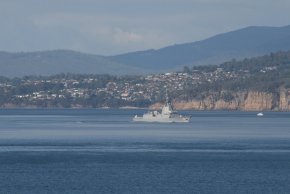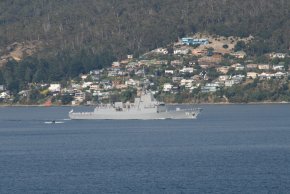Royal Australian Navy Discussions and Updates 2.0
- Thread starter OPSSG
- Start date
Scott Elaurant
Well-Known Member
I appreciate this is a practical and political concern, however it is also something that is quite managable if planned and budgeted for from the start. The USN has an excellent system where SSN reactors are disposed of as complete units (see photo below). The UK is also quite capable of safely disposing of retired SSN reactors; the problem there has been financial (nobody budgeted for it) not technical.This is a sobering article wrt SSN after life. What ever choice is made for the RAN’s SSN will likely be heavily weighted by disposal considerations.

Project to dismantle ex-Royal Navy nuclear submarines inches forward - Navy Lookout
There are currently 21 former Royal Navy nuclear submarines awaiting disposal, 7 in Rosyth and 14 in Devonport. Here we look at the process and the modest progress in efforts to dismantle them. Kicking the can down the road Since the 1960s, nuclear submarines have become arguably amongst the...www.navylookout.com
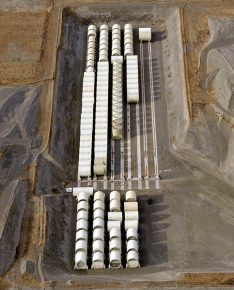
In practice SSN reactors are quite small and the amount of waste produced is tiny - the size of a fridge. There is already a national radioactive waste depository site in South Australia for medical isotope waste near Kimba. It is being upgraded and could easily acomodate the SSN waste as well with minimal expansion. I had some involvement in the SA Royal Commission into a possible nuclear waste disposal site. The scheme was technically highly feasible. SA geology is perfect for it. The problem was it was uneconomic. But if Australian SSNs go ahead, it would be technically quite feasible to do it all here.
Last edited:
John Fedup
The Bunker Group
Certainly AS is suitable for long term storage and likely would not have the NIMBY opposition. However, nuclear medicine radioisotopes with the exception of Cs-137 are mostly short half-life radionuclides. Reactor cores being buried is ok I assume but what about the fuel rods? Spent fuel rods (from commercial reactors) are the biggest disposal issue and they are highly radioactive with very long half-life radioisotopes.I appreciate this is a practical and political concern, however it is also something that is quite managable if planned and budgeted for from the start. The USN has an excellent system where SSN reactors are disposed of as complete units (see photo below). The UK is also quite capable of safely disposing of retired SSN reactors; the problem there has been financial (nobody budgeted for it) not technical.
View attachment 48890
In practice SSN reactors are quite small and the amount of waste produced is tiny - the size of a fridge. There is already a national radioactive waste depository site in South Australia for medical isotope waste near Kimba. It is being upgraded and could easily acomodate the SSN waste as well with minimal expansion. I had some involvement in the SA Royal Commission into a possible nuclear waste disposal site. The scheme was technically highly feasible. SA geology is perfect for it. The problem was it was uneconomic. But if Australian SSNs go ahead, it would be technically quite feasible to do it all here.
Scott Elaurant
Well-Known Member
John
Removal of the spent fuel rods is the first step in the process. This leaves the reactor vessel remaining with low level radioactive material. In the USN system the fuel rods are transported to their NRF site for reprocessing. The remaining reactor vessel is sealed and stored in the photo I showed above. As I said the fuel rods are small by volume - about the size of a Fridge. I would not propose Australia established a nuclear fuel reprocessing facility. The fuel rods should be sent back to the country of origin for reprocessing and disposal. That would need to be negotiated at the time of purchase. This would also resolve any issues with accounting for the amount of uranium fuel Australia possessed for NNPT purposes.
This has already been happening (about every ten years) for disposal of the spent fuel rods from the Lucas Heights reactor Australia already operates. Those spent fuel cores are sent to France for reprocessing. So this is a step Australia can already do. It is kept quiet for security reasons but ANSTO and ARPANSA have an excellent safety record in fuel rod disposal. We are talking about small quantities in both cases (i.e. Lucas Heights and SSN reactors). See:
Nuclear waste from Australia's only reactor ready to be dumped
Removal of the spent fuel rods is the first step in the process. This leaves the reactor vessel remaining with low level radioactive material. In the USN system the fuel rods are transported to their NRF site for reprocessing. The remaining reactor vessel is sealed and stored in the photo I showed above. As I said the fuel rods are small by volume - about the size of a Fridge. I would not propose Australia established a nuclear fuel reprocessing facility. The fuel rods should be sent back to the country of origin for reprocessing and disposal. That would need to be negotiated at the time of purchase. This would also resolve any issues with accounting for the amount of uranium fuel Australia possessed for NNPT purposes.
This has already been happening (about every ten years) for disposal of the spent fuel rods from the Lucas Heights reactor Australia already operates. Those spent fuel cores are sent to France for reprocessing. So this is a step Australia can already do. It is kept quiet for security reasons but ANSTO and ARPANSA have an excellent safety record in fuel rod disposal. We are talking about small quantities in both cases (i.e. Lucas Heights and SSN reactors). See:
Nuclear waste from Australia's only reactor ready to be dumped
Last edited:
Scott Elaurant
Well-Known Member
Sorry if this is a departure from naval content but it is relevant to the successful implementation of the SSN program. Australia will need to increase the size and capability of both ARPANSA and ANSTO to complete waste disposal and nuclear safety verification for the SSN program. In my view this is quite achievable by expanding the existing organisations. There will be a cost, but it is manageable within the overall SSN cost. For example, ARPANSA has an existing budget of about $30 million per annum. Establishing a second division in Adelaide for overseeing ASC and SSN safety at $30 million per annum would cost $900 million over 30 years or about 2% of the Attack class budget. ANSTO has a budget of about $60 million a year and would presumably also need to be boosted. So perhaps in combination a cost of an extra $50 to 60 million per annum for ARPANSA and ANSTO, say an extra $1.5 billion over 30 years. This cost would deliver many benefits in verifying safe operations for RAN SSN crews. ARPANSA and ANSTO annual reports are linked below if anyone is interested.
Last edited:
John Fedup
The Bunker Group
Ok if the fuel rods are sent back to the country of origin, that greatly simplifies the storage/disposal issue for Australia. This requirement could well favour a US order as they don’t have as many potential NIMBY issues like the UK and USN/DOE disposal capabilities are reasonably well established.John
Removal of the spent fuel rods is the first step in the process. This leaves the reactor vessel remaining with low level radioactive material. In the USN system the fuel rods are transported to their NRF site for reprocessing. The remaining reactor vessel is sealed and stored in the photo I showed above. As I said the fuel rods are small by volume - about the size of a Fridge. I would not propose Australia established a nuclear fuel reprocessing facility. The fuel rods should be sent back to the country of origin for reprocessing and disposal. That would need to be negotiated at the time of purchase. This would also resolve any issues with accounting for the amount of uranium fuel Australia possessed for NNPT purposes.
This has already been happening (about every ten years) for disposal of the spent fuel rods from the Lucas Heights reactor Australia already operates. Those spent fuel cores are sent to France for reprocessing. So this is a step Australia can already do. It is kept quiet for security reasons but ANSTO and ARPANSA have an excellent safety record in fuel rod disposal. We are talking about small quantities in both cases (i.e. Lucas Heights and SSN reactors). See:
Nuclear waste from Australia's only reactor ready to be dumped
Scott Elaurant
Well-Known Member
John
Possibly yes. It is only hearsay on another blog I have read but the suggestion is that at present there is an investigation under way to see if a US S9G reactor design can be fitted into an Astute hull. If that is possible it would be a perfect outcome for the RAN in my view. The reactor cores would be US supplied via BXT, and the hull could be made by BAE at Adelaide, with the rector compartment presumably made in Barrow, UK. Using modular construction techniques pioneered by Electric Boat but now used by BAE as well, this would be quite feasible if the reactor design can fit. If the S9G cannot fit in an Astute, and Rolls Royce are not making any more PWR2 reactors, I think the RAN might then have to go with Virginia Block IV. But that is pure speculation.
Also it should be pointed out that, perhaps for this reason, the RN is finally moving to speed up their own SSN reactor core disposal backlog. If they can get that program under way then Australian Astutes with a PWR2 reactor could join the end of the queue when the RAN retired them. It is a long term issue, but I agree it is important to have an answer for it when Australia signs up to an SSN design, so that we are not stuck with a similar legacy issue to the RN.
Moderator
I hope I have not gone too far in this and feel free to strike anything you are not happy with. Everything I have discussed is on the public record and I think it is relevant to undestanding the technical issues in a rational SSN choice for the RAN. Also, at some point the navy will need to be able to explain these issues to the community so that we can demonstrate that the SSN build and operation will be done safely for both sailors and nearby residents. In fact Australia has had a long track record of safely disposing of low level nuclear waste. We need to do more of the same, while meeting RN and/or USN nuclear safety standards.
@Scott Elaurant As far as I am concerned your posts are quite relevant to the discussion because the disposal of the waste material is an issue that has to be discussed. It is part and parcel of any SSN acquisition.
Welcome aboard and it's nice to have someone with some knowledge of the disposal of nuclear waste.
Ngatimozart.
Possibly yes. It is only hearsay on another blog I have read but the suggestion is that at present there is an investigation under way to see if a US S9G reactor design can be fitted into an Astute hull. If that is possible it would be a perfect outcome for the RAN in my view. The reactor cores would be US supplied via BXT, and the hull could be made by BAE at Adelaide, with the rector compartment presumably made in Barrow, UK. Using modular construction techniques pioneered by Electric Boat but now used by BAE as well, this would be quite feasible if the reactor design can fit. If the S9G cannot fit in an Astute, and Rolls Royce are not making any more PWR2 reactors, I think the RAN might then have to go with Virginia Block IV. But that is pure speculation.
Also it should be pointed out that, perhaps for this reason, the RN is finally moving to speed up their own SSN reactor core disposal backlog. If they can get that program under way then Australian Astutes with a PWR2 reactor could join the end of the queue when the RAN retired them. It is a long term issue, but I agree it is important to have an answer for it when Australia signs up to an SSN design, so that we are not stuck with a similar legacy issue to the RN.
Moderator
I hope I have not gone too far in this and feel free to strike anything you are not happy with. Everything I have discussed is on the public record and I think it is relevant to undestanding the technical issues in a rational SSN choice for the RAN. Also, at some point the navy will need to be able to explain these issues to the community so that we can demonstrate that the SSN build and operation will be done safely for both sailors and nearby residents. In fact Australia has had a long track record of safely disposing of low level nuclear waste. We need to do more of the same, while meeting RN and/or USN nuclear safety standards.
@Scott Elaurant As far as I am concerned your posts are quite relevant to the discussion because the disposal of the waste material is an issue that has to be discussed. It is part and parcel of any SSN acquisition.
Welcome aboard and it's nice to have someone with some knowledge of the disposal of nuclear waste.
Ngatimozart.
Last edited by a moderator:
HMAS Hobart in position on the Derwent and dressed for the occasion as flagship of the 2022 Royal Hobart Regatta. She is continuing the tradition of the RAN providing the flagship, something that has happened almost every year since the navy's founding in 1911.
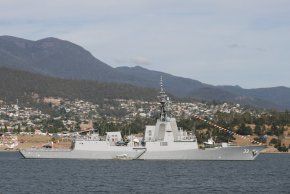
Up until the early 1950s Regatta week was a resting stop for the fleet's annual cruise and I still remember a SEATO exercise in 1951 when a fleet of no less than 14 warships led by the aircraft carrier HMAS Sydney and the heavy cruiser HMAS Australia, visited Hobart. A flypast directly over my home by Sea Fury and Firefly aircraft as HMAS Sydney neared Hobart, a subsequent tour of HMAS Australia and a massed fireworks display put on by the assembled fleet, started a lifelong interest in all things naval, which has never passed. I was just 6 years old at the time but I have never forgotten the experience. I doubt I'll ever again see such an impressive naval force on the Derwent in my lifetime.
Tas

Up until the early 1950s Regatta week was a resting stop for the fleet's annual cruise and I still remember a SEATO exercise in 1951 when a fleet of no less than 14 warships led by the aircraft carrier HMAS Sydney and the heavy cruiser HMAS Australia, visited Hobart. A flypast directly over my home by Sea Fury and Firefly aircraft as HMAS Sydney neared Hobart, a subsequent tour of HMAS Australia and a massed fireworks display put on by the assembled fleet, started a lifelong interest in all things naval, which has never passed. I was just 6 years old at the time but I have never forgotten the experience. I doubt I'll ever again see such an impressive naval force on the Derwent in my lifetime.
Tas
John Fedup
The Bunker Group
The S9G reactor being fitted to an Astute hull may be a win-win outcome for all parties. The US retains control over the nuclear reactor and doesn’t have to be concerned about sharing production of SSNs with Australia. The Brits get to build the actual boats and enhance their abilities to expand the SSN(R) program. Australia wins by getting a less crew intensive boat with a state-of-art reactor and a proven disposal capability that the US has.
The last report created so much negativity from our pathetically ignorant journalists and now there’s a positive report, nothing/nyet/nada in the mainstream media. FMD!
Anyway, good news about probably the most significant progression of the Hunters’ capability.

 asiapacificdefencereporter.com
asiapacificdefencereporter.com
Anyway, good news about probably the most significant progression of the Hunters’ capability.

Hunter program delivers major engineering milestone - APDR
The Hunter Class Frigate Program has successfully held a major engineering review, which defines how the Australian Combat System integrates into the Global Combat Ship reference ship design.
It was strange those articles only noted the leaked report's areas of concern, but not any recommended solutions.The last report created so much negativity from our pathetically ignorant journalists and now there’s a positive report, nothing/nyet/nada in the mainstream media. FMD!
Anyway, good news about probably the most significant progression of the Hunters’ capability.
It'll be interesting to see what path has been/is being taken in regards to power. A second MT30?
Last edited:
Problem is with what room? Is there enough physical space anywhere on the ship to place it let alone in the engine compartment with out redesigning surrounding compartments which could very well lead to a cascading effect of redesigning half the ship.It was strange those articles only noted the leaked report's areas of concern, but not any recommended solutions.
It'll be interesting to see what path has been/is being taken in regards to power. A second MT30?
If anyone knows what is the power output of the MT30 in the Hunters as designed? I know they are rated between 25 to 40 MW but can they cycle between these levels or are they built to achieve a certain power rating with the defined range (ie: could they be uprated to full 40 MW). I simply don't know so just like to get what facts are available before giving a fixed opinion.
36 or 40 MW with 'more power available on a case by case basis' - per Rolls Royce.Problem is with what room? Is there enough physical space anywhere on the ship to place it let alone in the engine compartment with out redesigning surrounding compartments which could very well lead to a cascading effect of redesigning half the ship.
If anyone knows what is the power output of the MT30 in the Hunters as designed? I know they are rated between 25 to 40 MW but can they cycle between these levels or are they built to achieve a certain power rating with the defined range (ie: could they be uprated to full 40 MW). I simply don't know so just like to get what facts are available before giving a fixed opinion.
- Thread Starter Thread Starter
- #714
@Scott Elaurant, we can’t thank you enough for sharing and helping us learn more about factors to consider when discussing SSN costs on a lifecycle basis. Really grateful for your on-point input here.Moderator
I hope I have not gone too far in this and feel free to strike anything you are not happy with. Everything I have discussed is on the public record and I think it is relevant to undestanding the technical issues in a rational SSN choice for the RAN. Also, at some point the navy will need to be able to explain these issues to the community so that we can demonstrate that the SSN build and operation will be done safely for both sailors and nearby residents. In fact Australia has had a long track record of safely disposing of low level nuclear waste. We need to do more of the same, while meeting RN and/or USN nuclear safety standards.
Last edited:
Scott Elaurant
Well-Known Member
Thanks OPSSG. As a land-lubber engineer-economist I have learnt a lot about ships on this blog too!@Scott Elaurant, we can’t thank you enough for sharing and helping us learn more about factors to consider when discussing SSN costs on a lifecycle basis. Really grateful for your on-point input here.
I am mainly posting because I think there has been far too little factual information put in the public domain to have an informed debate about submarines (nuclear and conventional) in Australia. I believe that when there is a better understanding of the costs of AUKUS SSNs, while it is high, there will be a better appreciation that SSNs for the RAN are an achievable goal, provided all required infrastructure and organisational support are put in place. That is achievable within the sorts of program costs suggested for the Attack Class. This is also provided we pick the right design, and partnering arrangements.
Meanwhile in the working Navy, some positive news :
"Close-In-Weapon-System (CWIS) student graduates from the first 1B2 CIWS course run in Australia. The course previously has a failure rate due to the complexity and multiple disciplines required to maintain the system. The CIWS student have been on course since the 4th of May and have navigated their way through training during a global pandemic. A shortage of trained CIWS maintainers currently exists in the workforce, so it is a great achievement and benefit to the capability of the RAN to have 5 professional and motivated maintainers graduate." Image Source : ADF Image Library
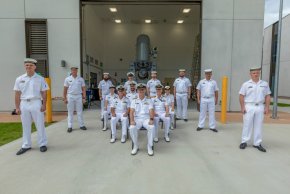
"Close-In-Weapon-System (CWIS) student graduates from the first 1B2 CIWS course run in Australia. The course previously has a failure rate due to the complexity and multiple disciplines required to maintain the system. The CIWS student have been on course since the 4th of May and have navigated their way through training during a global pandemic. A shortage of trained CIWS maintainers currently exists in the workforce, so it is a great achievement and benefit to the capability of the RAN to have 5 professional and motivated maintainers graduate." Image Source : ADF Image Library

And HMAS Supply now on station at Tonga conducting a RAS with HMAS Adelaide. Image Source : ADF Image Library
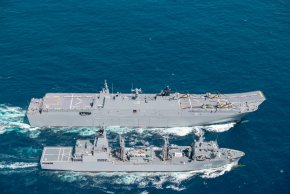

The Phalanx located within the building certainly looks a uniform grey colour.Meanwhile in the working Navy, some positive news :
"Close-In-Weapon-System (CWIS) student graduates from the first 1B2 CIWS course run in Australia. The course previously has a failure rate due to the complexity and multiple disciplines required to maintain the system. The CIWS student have been on course since the 4th of May and have navigated their way through training during a global pandemic. A shortage of trained CIWS maintainers currently exists in the workforce, so it is a great achievement and benefit to the capability of the RAN to have 5 professional and motivated maintainers graduate." Image Source : ADF Image Library
View attachment 48893
Not the White and grey seen on active ships.
I wonder if this is a new colour scheme for the most resent Phalanx block upgrade, or just the colour of the training unit?
Regards S
The Chinooks on Adelaide’s flight deck really give a sense of scale. What a great shot.And HMAS Supply now on station at Tonga conducting a RAS with HMAS Adelaide. Image Source : ADF Image Library
View attachment 48895
As someone who partakes in photography themselves, I’d almost certainly put that down, purely, to the effects of light.The Phalanx located within the building certainly looks a uniform grey colour.
Not the White and grey seen on active ships.
I wonder if this is a new colour scheme for the most resent Phalanx block upgrade, or just the colour of the training unit?
Regards S
I’ve noticed ADF photography editing is seemingly often done either sloppily or on an overly tight schedule - which leads to such issues.
Most problems being fixable with another five minutes of tinkering.

